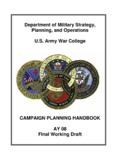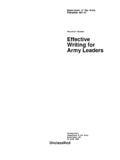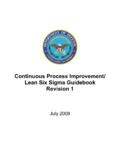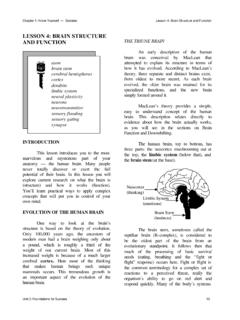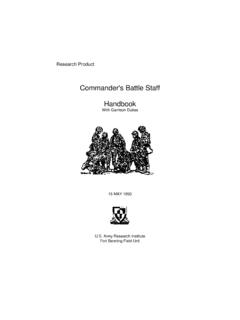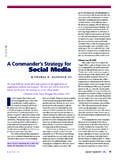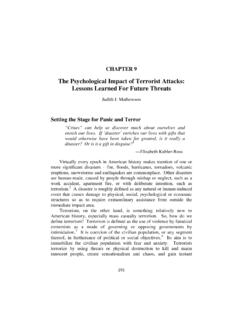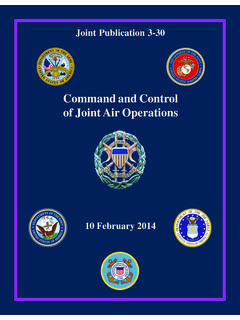Transcription of Crisis Action Planning - Air University
1 5-1 JFSC PUB 1 Crisis Action Planning Chapter 5 Introduction to Crisis Action Planning 5-2 Crisis Action Procedures 5-8 Crisis Action Procedures Single- Crisis Environment 5-9 Crisis Action Procedures Multiple- Crisis Environment 5-29 joint Planning Summary 5-31 Summary of Crisis Action Planning 5-32 5-2 JFSC PUB 1 Crisis Action Planning References: joint Pub 1-03 series, joint Reporting Structure joint Pub 5-0, Doctrine for Planning joint operations CJCSM , joint Operation Planning and execution system (JOPES) Volume I, Planning Policies and Procedures 500. INTRODUCTION TO Crisis Action Planning a. Overview. In peacetime, deliberate Planning procedures are used to evaluate anticipated future situations to which the United States must be prepared to respond mili-tarily. Because of their relative probability, importance to national security, and dif-ficulty in scale of military response required to resolve them, these situations are hypo-thetical predictions of regional conditions and scenarios that are considered so critical that plans to respond to them must be prepared before they occur.
2 Twelve months or more may be required to identify adequate responses, conduct the evaluation to select the best course of Action , and prepare a feasible OPLAN. It is noteworthy that these potential situations are based on the best available intelligence, but are still hypothetical to the ex-tent that not all conditions can be predicted, and, even if all variations of a future situation could be anticipated, Planning for all cannot be done feasibly. Further, in deliberate Planning , resources are apportioned for Planning . Even though forces, sustainment, and transportation resources apportioned to a plan may be sourced to that plan s requirements in anticipation of the event, the actual situation with respect to those particular resources may prevent them from being allocated by the National Command Authorities (NCA) to a real-time Crisis response.
3 (1) While deliberate Planning is conducted in anticipation of future events, there are always situations arising that might require military response. Such situations may approximate those previously planned for in deliberate Planning , though it is unlikely they would be identical. In some instances they will be completely unantici-pated. Usually, the time available to plan responses to such real-time events is short. In as little as a few days, a feasible course of Action must be developed and approved, and timely identification of resources accomplished to ready forces, schedule transportation, and prepare supplies for movement and employment of military force. In such time-sensitive Crisis situations, the joint Planning and execution Community (JPEC) uses Cri-sis Action Planning (CAP) procedures, prescribed in CJCSM , JOPES Volume I.
4 (2) In a Crisis , the situation is dynamic, with the body of knowledge growing hour by hour from the latest information sources and intelligence reports. An adequate and feasible military response in a Crisis demands flexible procedures keyed to the time 5-3 JFSC PUB 1 available, to communications that are rapid and effective, and to the use of previous plan-ning, whenever possible. The key members of the JPEC need to know what others are doing, and they need to know what is expected of them. (3) Crisis Action Planning procedures are used by the JPEC to plan and execute the deployment and employment of military forces in Crisis situations. These procedures ensure the following: That logical procedures are followed that begin with recognizing the problem and developing the solution, and progress to preparing and executing the opera-tion order; rapid and effective exchange of information about the situation, its analysis, and alternative military responses; timely preparation of military courses of Action for consideration by the NCA; and timely relay of the decisions of the NCA to the combatant commander to permit effective execution .
5 (4) The system is divided into six separate phases illustrated in Figure 5-1; each has a definite start, a finish, and actions to be performed. The roles of the key members of the JPEC are described as a checklist and a view of the overall process. The proce-dures begin when the situation develops; the theater commander recognizes the potential significance of the event and reports it, along with his assessment, to the National Mili-tary Command Center (NMCC). It also is possible that the situation may be reported to the NCA through other government agency channels such as the Department of State (DOS) or Central Intelligence Agency (CIA). It most cases the NMCC receives these reports and is responsible for their dissemination to the military chain of command. The NCA assess its diplomatic, economic, and informational implications and decide that a possible military response should be prepared.
6 The CINC develops military courses of Action in response to the situation. Should the NCA decide on the use of military forces to resolve the Crisis , the NCA will select a COA for full development by the CINC. By direction of CJCS, the CINC prepares the detailed operation order (OPORD) to support the selected COA. At the direction of the NCA, the CINC executes the OPORD. Though this is a step-by-step academic description, in reality, the process is flexible. It permits the steps to be done sequentially or concurrently, or skipped altogether while en-suring that no critical Planning factor is overlooked. The exact flow of the procedures is largely determined by the time available to complete the Planning and by the significance of the Crisis . (5) Members of the JPEC are busy during the accelerated Planning of a military response to a Crisis .
7 Figure 5-2 illustrates the primary responsibilities of the joint Plan-ning and execution Community during Crisis Action . 5-4 JFSC PUB 1 SUMMARY OF Crisis Action Planning PHASES Phase I Phase II Phase III Phase IV Phase V Phase VI Situation Development Crisis Assessment Course of Action Development Course of Action Selection execution Planning execution Event Event occurs with possible national security implications CINC s REPORT/ ASSESSMENT received CJCS sends WARNING ORDER CJCS presents refined and prioritized COAs to NCA CINC re-ceives ALERT ORDER or Planning ORDER NCA decide to execute OPORD Action Monitor world situation Recognize prob-lem Submit CINC s ASSESSMENT Monitor report-ing from other agencies. Increase aware-ness Increase report-ing JS assesses situation JS advises on possible military Action NCA-CJCS evaluates Develop COAs CINC assigns tasks to sub-ordinates by evaluation re-quest message CINC reviews evaluation re-sponse mes-sages Create/modify TPFDD USTRANSCOM prepares de-ployment esti-mates Evaluate COAs CJCS advises NCA CJCS may send Planning ORDER to be-gin execution Planning be-fore formal se-lection of COA by NCA CINC devel-ops OPORD Refine TPFDD Force prepa-ration CJCS sends EXECUTE ORDER by au-thority of SECDEF CINC executes OPORD JOPES data-base main-tained JPEC reports execution status Begin rede-ployment plan-ning Outcome Assess that event may have national implica-tions Report the event to NCA/ CJCS NCA/CJCS de-cide to develop military COA CINC sends
8 Commander s Estimate with recommended COA NCA select COA CJCS releases COA selection by NCA in ALERT ORDER CINC sends OPORD Crisis resolved Redeployment of forces Figure 5-1 (6) Military planners facing Crisis Action Planning requirements must under-stand that the NCA are considering diplomatic, informational, economic, and military options. The military option may initially be the least desirable option, and a decision to execute it may be made only after other, less drastic options have been judged unsuitable or ineffective to resolve the situation. In reaching a decision to develop a military COA, the NCA may consider the whole range of flexible deterrent options described in Chapter 4. Ultimate responsibility and authority in a Crisis rest with the NCA, who must approve a COA and authorize the major actions to be taken, including the deployment, employ-ment, or redeployment of forces.
9 5-5 JFSC PUB 1 ACTIVITIES OF THE joint Planning & execution COMMUNITY DURING Crisis Action Planning NCA Approve the COA Direct that major actions be taken, , change deployment status, deploy forces, activate reserve forces call up Authorize conduct of military operations against a potential enemy CJCS, The joint Staff Manage Planning process: review & analyze reports, resolve conflicts & shortfalls monitor deployment or employment Offer options and recommendations to the NCA Convey NCA decisions to military commands Supported Command Responds to, monitors and reports on a Crisis Prepares Commander s Estimate Develops COAs with assistance of subordinate and supporting commands Develops Operation Order for deployment or employment Subordinate Command Conducts parallel Planning with supported command Determines the force and resource requirements Develops employment plan Supporting Command Generates and sources force and support requirements Makes deployment estimates for organic lift assets USTRANSCOM Coordinates deployment Planning & execution Makes deployment estimates Develops transportation-feasible schedules Optimizes use of transportation capability Reports progress of deployment to CJCS and supported commander Services Furnish additional support forces through subordinate component commanders Identify and prepare reserve forces
10 Figure 5-2 b. Definition. joint Pub 5-0, Doctrine for Planning joint operations , and CJCSM , JOPES Volume I, define a Crisis within the context of joint operation Planning and execution . It is described as an incident or situation involving a threat to the United States, its territories, citizens, military forces, and possessions or vital interests that de-velops rapidly and creates a condition of such diplomatic, economic, political, or military importance that commitment of military forces and resources is contemplated to achieve national objectives. Several characteristics of a Crisis can be given: it may occur with little or no warning; it may be fast breaking requiring accelerated decisions; and, sometimes, a single Crisis may spawn another Crisis elsewhere. Whatever the nature or perceived magnitude of the situation, a commitment of military forces and resources is being considered as a solution.
